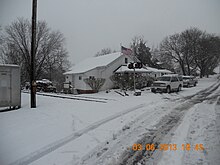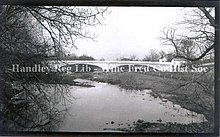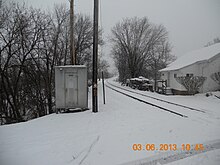
The First Battle of Winchester, fought on May 25, 1862, in and around Frederick County, Virginia, and Winchester, Virginia, was a major victory in Confederate Army Maj. Gen. Thomas J. "Stonewall" Jackson's Campaign through the Shenandoah Valley during the American Civil War. Jackson enveloped the right flank of the Union Army under Maj. Gen. Nathaniel P. Banks and pursued it as it fled across the Potomac River into Maryland. Jackson's success in achieving force concentration early in the fighting allowed him to secure a more decisive victory which had escaped him in previous battles of the campaign.
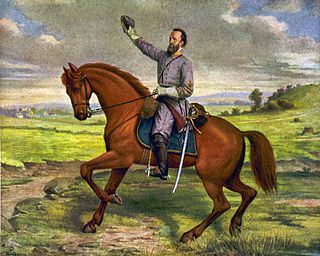
Jackson's Valley campaign, also known as the Shenandoah Valley campaign of 1862, was Confederate Maj. Gen. Thomas J. "Stonewall" Jackson's spring 1862 campaign through the Shenandoah Valley in Virginia during the American Civil War. Employing audacity and rapid, unpredictable movements on interior lines, Jackson's 17,000 men marched 646 miles (1,040 km) in 48 days and won several minor battles as they successfully engaged three Union armies, preventing them from reinforcing the Union offensive against Richmond.

The Battle of Front Royal, also known as Guard Hill or Cedarville, was fought on May 23, 1862, during the American Civil War, as part of Jackson's Valley campaign. Confederate forces commanded by Major General Thomas J. "Stonewall" Jackson were trying to keep Union forces engaged in the Shenandoah Valley to prevent them from joining the Peninsula campaign. After defeating Major General John C. Frémont's force in the Battle of McDowell, Jackson turned against the forces of Major General Nathaniel Banks.

The Second Battle of Winchester was fought between June 13 and June 15, 1863, in Frederick County and Winchester, Virginia as part of the Gettysburg Campaign during the American Civil War. As Confederate Lieutenant General Richard S. Ewell moved north through the Shenandoah Valley in the direction of Pennsylvania, his corps defeated the Union Army garrison commanded by Major General Robert H. Milroy, capturing Winchester and numerous Union prisoners.

The Third Battle of Winchester, also known as the Battle of Opequon or Battle of Opequon Creek, was an American Civil War battle fought near Winchester, Virginia, on September 19, 1864. Union Army Major General Philip Sheridan defeated Confederate Army Lieutenant General Jubal Early in one of the largest, bloodiest, and most important battles in the Shenandoah Valley. Among the 5,000 Union casualties were one general killed and three wounded. The casualty rate for the Confederates was high: about 4,000 of 15,500. Two Confederate generals were killed and four were wounded. Participants in the battle included two future presidents of the United States, two future governors of Virginia, a former vice president of the United States, and a colonel whose grandson, George S. Patton became a famous general in World War II.

The Valley campaigns of 1864 began as operations initiated by Union Lieutenant General Ulysses S. Grant and resulting battles that took place in the Shenandoah Valley of Virginia during the American Civil War from May to October 1864. Some military historians divide this period into three separate campaigns. This article considers them together, as the campaigns interacted and built upon one another.
The Army of the Valley was the name given to the army of Lt. Gen. Jubal Early's independent command during the Shenandoah Valley Campaigns in the summer and autumn of 1864. The Army of the Valley was the last Confederate unit to invade Northern territory, reaching the outskirts of Washington, D.C. The Army became defunct after its decisive defeat at the Battle of Waynesboro, Virginia, on March 2, 1865.

Ashby Gap, more commonly known as Ashby's Gap is a wind gap in the Blue Ridge Mountains on the border of Clarke County, Loudoun County and Fauquier County in Virginia. The gap is traversed by U.S. Route 50. The Appalachian trail also passes across the gap.
Loudoun County, Virginia, was destined to be an area of significant military activity during the American Civil War. Located on Virginia's northern frontier, the Potomac River, Loudoun County became a borderland after Virginia's secession from the Union in early 1861. Loudoun County's numerous Potomac bridges, ferries and fords made it an ideal location for the Union and Confederate armies to cross into and out of Virginia. Likewise, the county's several gaps in the Blue Ridge Mountains that connected the Piedmont to the Shenandoah Valley and Winchester were of considerable strategic importance. The opposing armies would traverse the county several times throughout the war leading to several small battles, most notably the Battle of Ball's Bluff.
The 5th West Virginia Infantry Regiment was an infantry regiment that served in the Union Army during the American Civil War.
The 9th West Virginia Infantry Regiment was an infantry regiment that served in the Union Army during the American Civil War.
The 91st Ohio Infantry Regiment, sometimes 91st Ohio Volunteer Infantry Regiment was an infantry regiment that served in the Union Army during the American Civil War. It primarily served in what became West Virginia and in the Shenandoah Valley of Virginia.

The city of Winchester, Virginia, and the surrounding area, were the site of numerous battles during the American Civil War, as contending armies strove to control the lower Shenandoah Valley. Winchester changed hands more often than any other Confederate city.
The Battle of Charlestown was a small engagement between Confederate cavalry forces under Brig. Gen. John D. Imboden and the Union forces under Col. Benjamin L. Simpson on October 18, 1863, at Charles Town, West Virginia, as part of the Bristoe and Mine Run Campaigns, resulting in a Confederate victory.

The 1st Virginia Cavalry Regiment was a cavalry regiment raised in Virginia for service in the Confederate States Army during the American Civil War. It fought mostly with the Army of Northern Virginia.
The 123rd Ohio Infantry Regiment, sometimes 123rd Ohio Volunteer Infantry was an infantry regiment in the Union Army during the American Civil War.

Eugene W. Ferris was a United States soldier who fought with the 30th Regiment Massachusetts Volunteer Infantry during the American Civil War. He received his nation's highest award for bravery during combat, the U.S. Medal of Honor, for resisting an attack by enemy cavalrymen near Berryville, Virginia on April 1, 1865. That award was conferred 32 years later on October 16, 1897.
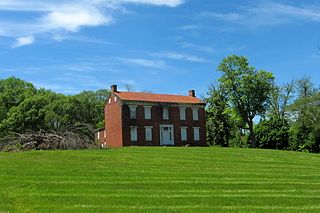
Millbank, also known as Spout Spring and Hillwood, is a historic house at 3100 Berryville Pike, in Frederick County, Virginia east of the city of Winchester. The two story brick mansion was built c. 1850 by Isaac and Daniel T. Wood. It is one of the largest Greek Revival houses in the county, standing on a hill overlooking Berryville Pike and Opequon Creek, which flows east of the property. The house has a typical I-house plan, with two entrances, one facing the highway and one the creek. Both were originally sheltered by Doric-columned porches, but the side entry's porch has been removed by vandals. The house was previously owned by the Winchester-Frederick Service Authority, who took the property in 1984 by eminent domain to construct the adjacent sewage treatment plant. It is now owned by The Fort Collier Civil War Center, Inc. (2014.) This nonprofit organization owns historic Fort Collier, another Third Battle of Winchester site.
The action at Abraham's Creek was an engagement on September 13, 1864 between Union Army and Confederate States Army forces during a Union reconnaissance in force toward Winchester, Virginia. The action occurred during skirmishing, maneuvering and scouting before the Third Battle of Winchester on September 19, 1864 in the Valley Campaigns of 1864 during the American Civil War. The Union force successfully completed the mission and captured about 173 Confederate prisoners.

The 5th New York Cavalry Regiment, also known as the 5th Regiment New York Volunteer Cavalry and nicknamed the "1st Ira Harris Guards", was a cavalry regiment of the Union Army during the American Civil War. The regiment had a good fighting reputation, and had important roles in the Battle of Hanover and the Battle of the Wilderness. It was present at nearly 175 battles and skirmishes, including Gettysburg, Opequon, and Cedar Creek. A majority of its fighting was in Virginia.
